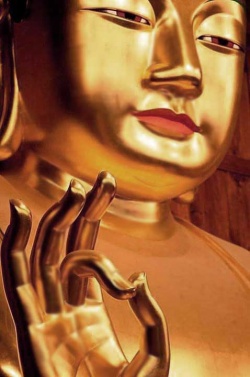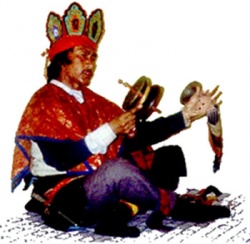Difference between revisions of "8 powers of realization"
(Created page with "<nomobile>{{DisplayImages|3993|3357}}</nomobile> <poem> 8 powers of realization; The Sambhogakaya can be characterized by 8 powers of realization: 1.The power of the b...") |
|||
| Line 3: | Line 3: | ||
<poem> | <poem> | ||
| − | [[8 powers of realization]]; The Sambhogakaya can be characterized by 8 powers of realization: | + | [[8 powers of realization]]; The [[Sambhogakaya]] can be characterized by 8 [[powers]] of [[realization]]: |
| − | 1.The power of the body. It is said that the power of the body becomes such that all things of samsaric and nirvanic nature become completely subdued and one is able to take full charge of them. Along with this power, one is enriched with many positive qualities. | + | 1.The [[power]] of the [[body]]. It is said that the [[power]] of the [[body]] becomes such that all things of [[samsaric]] and [[nirvanic]] [[nature]] become completely subdued and one is able to take full charge of them. Along with this [[power]], one is enriched with many positive qualities. |
| − | 2.The power of the verbal capacity or speech. In this case the capacity of speech or communication is such that all the essential verbal elements of both samsaric and nirvanic qualities become assimilated, and one is able to make full use of them. | + | 2.The [[power]] of the [[verbal]] capacity or [[speech]]. In this case the capacity of [[speech]] or [[communication]] is such that all the [[essential]] [[verbal]] [[elements]] of both [[samsaric]] and [[nirvanic]] qualities become assimilated, and one is able to make full use of them. |
| − | 3. The power of the mind in relation to both samsara and nirvana becomes assimilated and integrated, and one becomes empowered with all the different possibilities of mental manifestation. | + | 3. The [[power]] of the [[mind]] in [[relation]] to both [[samsara and nirvana]] becomes assimilated and integrated, and one becomes [[empowered]] with all the different possibilities of [[mental]] [[manifestation]]. |
| − | 4.The power of miracle, whereby the person's capacity of expression is such that he or she is not confined by the three gates of body, speech, and mind, but is able to go beyond conventional modes of expression, thus being able to display his or her power in unusual ways. | + | 4.The [[power]] of [[miracle]], whereby the person's capacity of expression is such that he or she is not confined by the three gates of [[body]], [[speech]], and [[mind]], but is able to go [[beyond]] [[Wikipedia:Convention (norm)|conventional]] modes of expression, thus [[being]] able to display his or her [[power]] in unusual ways. |
| − | 5.The Power of Activity. One is constantly being impelled toward action, toward the intention to act and to accomplish things for the benefit of others. So in terms of doing, or acting, one becomes fully endowed with varieties of powers related to samsaric and nirvanic qualities. | + | 5.The [[Power]] of [[Activity]]. One is constantly [[being]] impelled toward [[action]], toward the [[intention]] to act and to accomplish things for the [[benefit]] of others. So in terms of doing, or acting, one becomes fully endowed with varieties of [[powers]] related to [[samsaric]] and [[nirvanic]] qualities. |
| − | 6.The power of place. This means that the Sambhogakaya is situated in Akanishtha, which is basically the sphere of reality. | + | 6.The [[power]] of place. This means that the [[Sambhogakaya]] is situated in [[Akanishtha]], which is basically the [[sphere of reality]]. |
| − | One becomes enriched and empowered in this sense because Sambhogakaya is inseparably united with reality, and all the powers related with that can manifest. | + | One becomes enriched and [[empowered]] in this [[sense]] because [[Sambhogakaya]] is inseparably united with [[reality]], and all the [[powers]] related with that can [[manifest]]. |
| − | 7.The power of sensuality. This is connected with the idea that Sambhogakaya is inseparably in unity with its female counterpart, Wisdom, whether one calls that the mother of all Buddhas or the selfless one, Dag mema--or whether one calls it Vajravarahi or Vajrayogini. | + | 7.The [[power]] of [[sensuality]]. This is connected with the [[idea]] that [[Sambhogakaya]] is inseparably in {{Wiki|unity}} with its {{Wiki|female}} counterpart, [[Wisdom]], whether one calls that the mother of all [[Buddhas]] or the [[selfless]] one, Dag mema--or whether one calls it [[Vajravarahi]] or [[Vajrayogini]]. |
| − | Whatever one might call it, the female counterpart is continuously in unison with the Sambhogakaya, and this experience continuously produces the great bliss of unity, which is the Mahamudra expression as well. | + | Whatever one might call it, the {{Wiki|female}} counterpart is continuously in [[unison]] with the [[Sambhogakaya]], and this [[experience]] continuously produces the great [[bliss]] of {{Wiki|unity}}, which is the [[Mahamudra]] expression as well. |
| − | Finally, one is empowered by the capacities to manifest prajna or sherab. | + | Finally, one is [[empowered]] by the capacities to [[manifest]] [[prajna]] or sherab. |
| − | 8.The Power to fulfill one's wishes. | + | 8.The [[Power]] to fulfill one's wishes. |
</poem> | </poem> | ||
{{E}} | {{E}} | ||
[[Category:Sambhogakāya]] | [[Category:Sambhogakāya]] | ||
Revision as of 12:38, 24 October 2015
8 powers of realization; The Sambhogakaya can be characterized by 8 powers of realization:
1.The power of the body. It is said that the power of the body becomes such that all things of samsaric and nirvanic nature become completely subdued and one is able to take full charge of them. Along with this power, one is enriched with many positive qualities.
2.The power of the verbal capacity or speech. In this case the capacity of speech or communication is such that all the essential verbal elements of both samsaric and nirvanic qualities become assimilated, and one is able to make full use of them.
3. The power of the mind in relation to both samsara and nirvana becomes assimilated and integrated, and one becomes empowered with all the different possibilities of mental manifestation.
4.The power of miracle, whereby the person's capacity of expression is such that he or she is not confined by the three gates of body, speech, and mind, but is able to go beyond conventional modes of expression, thus being able to display his or her power in unusual ways.
5.The Power of Activity. One is constantly being impelled toward action, toward the intention to act and to accomplish things for the benefit of others. So in terms of doing, or acting, one becomes fully endowed with varieties of powers related to samsaric and nirvanic qualities.
6.The power of place. This means that the Sambhogakaya is situated in Akanishtha, which is basically the sphere of reality.
One becomes enriched and empowered in this sense because Sambhogakaya is inseparably united with reality, and all the powers related with that can manifest.
7.The power of sensuality. This is connected with the idea that Sambhogakaya is inseparably in unity with its female counterpart, Wisdom, whether one calls that the mother of all Buddhas or the selfless one, Dag mema--or whether one calls it Vajravarahi or Vajrayogini.
Whatever one might call it, the female counterpart is continuously in unison with the Sambhogakaya, and this experience continuously produces the great bliss of unity, which is the Mahamudra expression as well.
Finally, one is empowered by the capacities to manifest prajna or sherab.
8.The Power to fulfill one's wishes.

